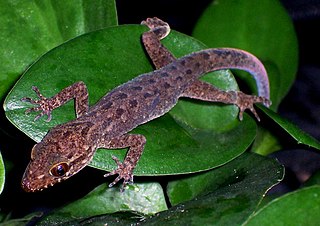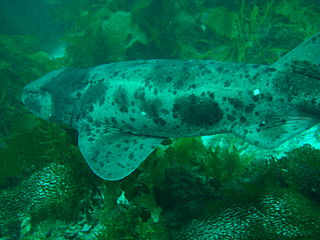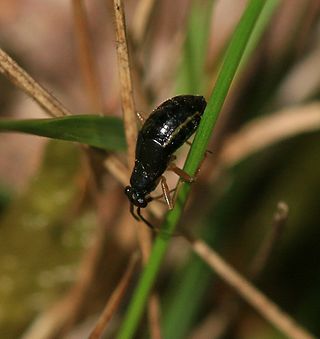
Minnow is the common name for a number of species of small freshwater fish, belonging to several genera of the families Cyprinidae and Leuciscidae. They are also known in Ireland as pinkeens.

Cyrtodactylus is a diverse genus of Asian geckos, commonly known as bent-toed geckos, bow-fingered geckos, and forest geckos. The genus has 354 described species as of 2023, which makes it the largest of all gecko genera.

Pyrrhocoridae is a family of insects with more than 300 species world-wide. Many are red coloured and are known as red bugs and some species are called cotton stainers because their feeding activities leave an indelible yellow-brownish stain on cotton crops. A common species in parts of Europe is the firebug, and its genus name Pyrrhocoris and the family name are derived from the Greek roots for fire "pyrrho-" and bug "coris". Members of this family are often confused with, but can be quickly separated from, Lygaeidae by the lack of ocelli on the top of the head.

Glis is a genus of rodent that contains two extant species, both known as edible dormice or fat dormice: the European edible dormouse (Glis glis) and the Iranian edible dormouse. It also contains a number of fossil species.

Pasteurella is a genus of Gram-negative, facultatively anaerobic bacteria. Pasteurella species are nonmotile and pleomorphic, and often exhibit bipolar staining. Most species are catalase- and oxidase-positive. The genus is named after the French chemist and microbiologist, Louis Pasteur, who first identified the bacteria now known as Pasteurella multocida as the agent of chicken cholera.

Spironemidae is a family of heterotrophic flagellates, in the group Hemimastigophora. They vary in size and shape from the ellipsoid Hemimastix amphikineta to the vermiform Spironema terricola, and are united by the possession of two rows of cilia, called kineties.

Pentatominae is a subfamily of Pentatomidae, a family of shield bugs. This subfamily is the largest one within the Pentatomidae, having 4937 species classified in 938 genera. Species in this subfamily are phytophages and several of them are considered agricultural pests. Some invasive pentatomines such as Halyomorpha halys and Bagrada hilaris have been considered household pests. Higher systematics of the group have been revised by Rider et al.

Acanthosomatidae is a family of Hemiptera, commonly named "shield bugs" or "stink bugs". Kumar in his 1974 world revision recognized 47 genera; now this number is 55 genera, with about 200 species, and it is one of the least diverse families within Pentatomoidea. The Acanthosomatidae species are found throughout the world, being most abundant in high-latitude temperate regions and in subtropical regions at high altitudes.
Ethelwynn Trewavas was an ichthyologist at the British Museum of Natural History. She was known for her work on the families Cichlidae and Sciaenidae. She worked with Charles Tate Regan, another ichthyologist and taxonomist.

Cephaloscyllium is a genus of catsharks, and part of the family Scyliorhinidae, commonly known as swellsharks because of their ability to inflate their bodies with water or air as a defense against predators. These sluggish, bottom-dwelling sharks are found widely in the tropical and temperate coastal waters of the Indian and Pacific Oceans. They have stocky, spindle-shaped bodies and short, broad, and flattened heads. The mouth is capacious, containing many small teeth and lacking furrows at the corners. The two dorsal fins are placed far back on the body, with the first much larger than the second. Different species have various color patterns of saddles, blotches, reticulations, and/or spots. The largest members of the genus can grow over 1 m (3.3 ft) in length. Swellsharks prey on a variety of fishes and invertebrates, and are oviparous, with females producing egg capsules in pairs. They are harmless and have been deemed of having no commercial value.

Mesostigmata is an order of mites belonging to the Parasitiformes. They are by far the largest group of Parasitiformes, with over 8,000 species in 130 families. Mesostigmata includes parasitic as well as free-living and predatory forms. They can be recognized by the single pair of spiracles positioned laterally on the body.

Pityrodia is a genus of flowering plants in the mint family, Lamiaceae and is endemic to Australia, most species occurring in Western Australia, a few in the Northern Territory and one in Queensland. Plants in this genus are shrubs with five petals joined to form a tube-shaped flower with four stamens of unequal lengths.

The Museonder is a Dutch museum in the De Hoge Veluwe National Park The museum focuses on the geology and biology of the Veluwe and calls itself the world's first fully underground museum. The name "Museonder" is a portmanteau of the Dutch words for "museum" and "under", respectively "museum" and "onder".

Picromerus is a genus of shield bugs in the family Pentatomidae.

Halyomorpha is a genus of shield bugs in the subfamily Pentatominae and tribe Cappaeini, erected by G. Mayr. This genus probably has an Asian centre of origin, but Halyomorpha halys, the brown marmorated stink bug, is an invasive species with a world-wide distribution.

Mecomma is a genus of plant bugs in the family Miridae. There are more than 30 described species in Mecomma.

Tytthoscincus is a genus of skinks. Originally defined to include a few species from the Philippines, the genus now includes many species from South-East Asia in general.

Leptocorisa is a genus of broad-headed bugs in the family Alydidae. There are about 17 described species in Leptocorisa, some of which are known as "rice bugs" or gundhi bugs ; they are found in south and east Asia and in Oceania.

The Micrelytrinae are a subfamily of true bugs in the family Alydidae, based on the type genus Micrelytra Laporte, 1833. Genera are recorded from the Americas, Europe and Asia.
Lonchiphora is a genus of glass sponge in the family Farreidae.


















